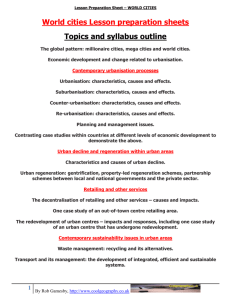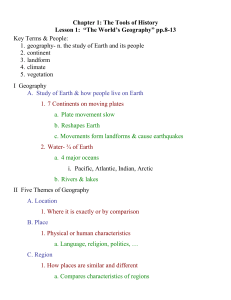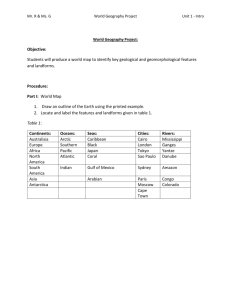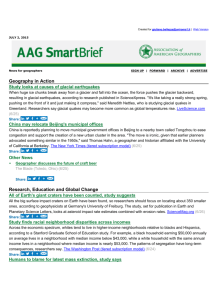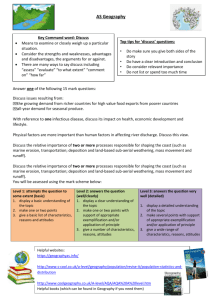Lesson Preparation Sheet Topic: Where are cold environments and
advertisement
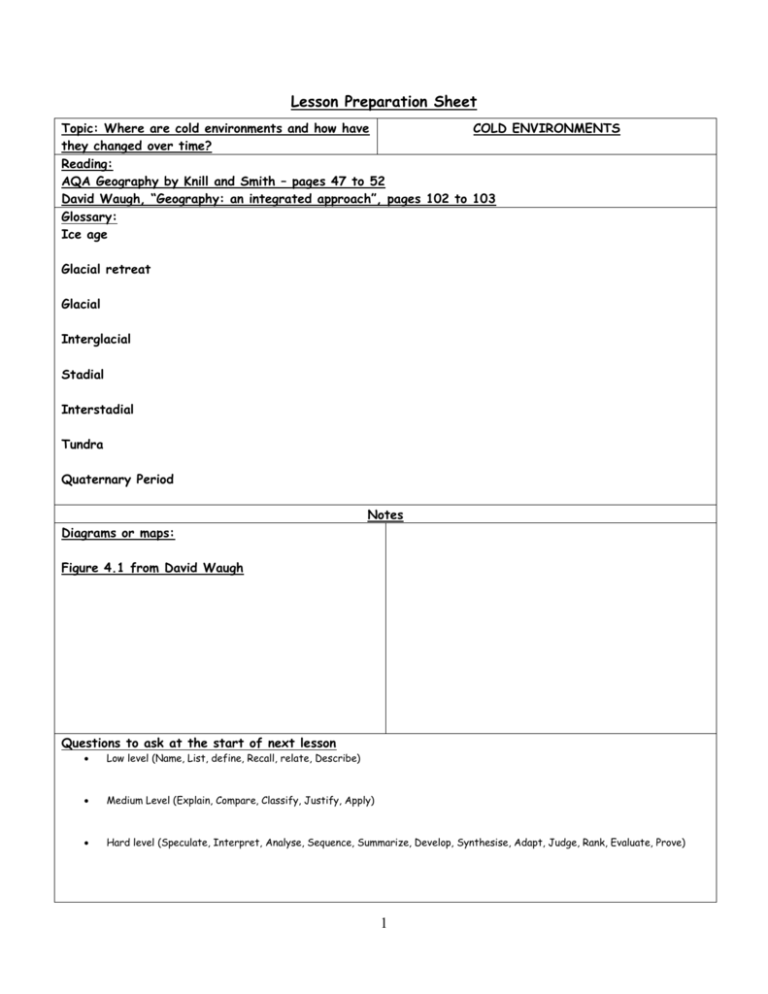
Lesson Preparation Sheet Topic: Where are cold environments and how have COLD ENVIRONMENTS they changed over time? Reading: AQA Geography by Knill and Smith – pages 47 to 52 David Waugh, “Geography: an integrated approach”, pages 102 to 103 Glossary: Ice age Glacial retreat Glacial Interglacial Stadial Interstadial Tundra Quaternary Period Notes Diagrams or maps: Figure 4.1 from David Waugh Questions to ask at the start of next lesson Low level (Name, List, define, Recall, relate, Describe) Medium Level (Explain, Compare, Classify, Justify, Apply) Hard level (Speculate, Interpret, Analyse, Sequence, Summarize, Develop, Synthesise, Adapt, Judge, Rank, Evaluate, Prove) 1 Lesson Preparation Sheet Topic: Why has climate changed over time? COLD ENVIRONMENTS Reading: AQA Geography by Knill and Smith – page 48 David Waugh, “Geography: an integrated approach”, pages 103 to 105 Glossary: Climatic Change Incoming Radiation Sunspot activity Volcanic Dust Ice core Notes Diagrams or maps: Figure 4.6 – Milankovitch diagrams Questions to ask at the start of next lesson Low level (Name, List, define, Recall, relate, Describe) Medium Level (Explain, Compare, Classify, Justify, Apply) Hard level (Speculate, Interpret, Analyse, Sequence, Summarize, Develop, Synthesise, Adapt, Judge, Rank, Evaluate, Prove) Case studies or examples Antarctica and Greenland 2 Lesson Preparation Sheet Topic: What is the glacial system? COLD ENVIRONMENTS Reading: AQA Geography by Knill and Smith – pages 48 to 51 David Waugh, “Geography: an integrated approach”, pages 105 to 107 Glossary: Sublimation Ice sheet Ice cap Valley Glacier Cirque Glacier Piedmont Glacier Polar Glacier (Polar ice) Temperate Glacier (Temperate ice) Firn (névé) Diagenesis Accumulation Zone Ablation Zone Firn (equilibrium) line Glacial Budget (Mass Balance) Surge Notes Diagrams or maps: Figure 2.6 in Knill and Smith Questions to ask at the start of next lesson Low level (Name, List, define, Recall, relate, Describe) Medium Level (Explain, Compare, Classify, Justify, Apply) Hard level (Speculate, Interpret, Analyse, Sequence, Summarize, Develop, Synthesise, Adapt, Judge, Rank, Evaluate, Prove) Case studies or examples Obruchev Glacier – to be completed in class – a summary here after the lessons would help. 3 Lesson Preparation Sheet Topic: How do Glaciers move? COLD ENVIRONMENTS Reading: AQA Geography by Knill and Smith – pages 52 to53 David Waugh, “Geography: an integrated approach”, pages 107 to 109 Glossary: Crevassing Plastic deformation Pressure melting point (PMP) Surface velocity Sub-surface velocity Basal sliding Slippage Creep Regelation Bed deformation Internal deformation Laminar flow Extending flow Compressing flow Supraglacial debris Englacial debris Subglacial debris Diagrams or maps: Figure 2.9 in Knill and Smith Notes Key points; Questions to ask at the start of next lesson Low level (Name, List, define, Recall, relate, Describe) Medium Level (Explain, Compare, Classify, Justify, Apply) Hard level (Speculate, Interpret, Analyse, Sequence, Summarize, Develop, Synthesise, Adapt, Judge, Rank, Evaluate, Prove) 4 Lesson Preparation Sheet Topic: Glacial landforms - Erosion COLD ENVIRONMENTS Reading: AQA Geography by Knill and Smith – pages 54 to 59 David Waugh, “Geography: an integrated approach”, pages 105 to 107 Glossary: Landform Cirque (corrie) Arête Pyramidal Peak Glacial Trough (U shaped valley) Truncated Spur Hanging Valley Striations Crag and Tail Roche Moutonnée Weathering Plucking Abrasion Rotational movement Fjord Notes Diagrams or maps: Figure 2.14 – a block diagram of glaciations features Questions to ask at the start of next lesson Low level (Name, List, define, Recall, relate, Describe) Medium Level (Explain, Compare, Classify, Justify, Apply) Hard level (Speculate, Interpret, Analyse, Sequence, Summarize, Develop, Synthesise, Adapt, Judge, Rank, Evaluate, Prove) Case studies or examples Here you will need to record located examples of each of these landforms; 5 Topic: Fluvio-glacial environments and processes COLD ENVIRONMENTS Reading: AQA Geography by Knill and Smith – pages 63 to 65 Advanced Geography by Palmer and Yates, pages343 to 348 Glossary: Meltwater Outwash Outwash or Fluvioglacial deposits Horizontal sorting Vertical stratification Jökulhaulps Ice Contract Drift Notes Diagrams or maps: Questions to ask at the start of next lesson Low level (Name, List, define, Recall, relate, Describe) Medium Level (Explain, Compare, Classify, Justify, Apply) Hard level (Speculate, Interpret, Analyse, Sequence, Summarize, Develop, Synthesise, Adapt, Judge, Rank, Evaluate, Prove) Case studies or examples Iceland - 6 Topic: Fluvio-glacial landforms COLD ENVIRONMENTS Reading: AQA Geography by Knill and Smith – pages 63 to 65 David Waugh, “Geography: an integrated approach”, pages 119 to121 Canadian Landscapes – “Glacial meltwater landforms” Glossary: Outwash (Fluvio-glacial) Meltwater (overspill) channels Pro-glacial lake Outwash plain (sandur) Varves Kettle holes Dead Ice Esker (Delta) Kame Kame Terrace Braided Streams Diagrams or maps: Notes How are fluvio glacial landforms different from glacial ones? Questions to ask at the start of next lesson Low level (Name, List, define, Recall, relate, Describe) Medium Level (Explain, Compare, Classify, Justify, Apply) Hard level (Speculate, Interpret, Analyse, Sequence, Summarize, Develop, Synthesise, Adapt, Judge, Rank, Evaluate, Prove) Case studies or examples Proglacial lakes in Waugh 7 Lesson Preparation sheet Topic: Where are periglacial areas? What are COLD ENVIRONMENTS they like? Reading: AQA Geography by Knill and Smith – pages 66 to 67 David Waugh “Geography: an integrated approach” pages 130 to 132 Glossary: Periglacial Permafrost Sporadic permafrost Discontinuous permafrost Continuous permafrost Frost Heave Frost shatter or freeze thaw Talik Active layer Nivation Solifluction Ice lenses Ground contraction Questions to ask at the start of next lesson Low level (Name, List, define, Recall, relate, Describe) Medium Level (Explain, Compare, Classify, Justify, Apply) Hard level (Speculate, Interpret, Analyse, Sequence, Summarize, Develop, Synthesise, Adapt, Judge, Rank, Evaluate, Prove) Case studies or examples Greenland and Canada 8 Lesson Preparation sheet Topic: Periglacial Landforms COLD ENVIRONMENTS Reading: AQA Geography by Knill and Smith – pages 67 to 69 David Waugh “Geography: an integrated approach” pages 132 to 136 Glossary: Sorted stone polygon Ice wedges Fossil Ice wedges Open System Pingos Closed system Pingos Blockfields Scree Loess Notes Diagrams or maps: Any from Waugh Questions to ask at the start of next lesson Low level (Name, List, define, Recall, relate, Describe) Medium Level (Explain, Compare, Classify, Justify, Apply) Hard level (Speculate, Interpret, Analyse, Sequence, Summarize, Develop, Synthesise, Adapt, Judge, Rank, Evaluate, Prove) Case studies or examples Northern Canada 9 Lesson Preparation Sheet Topic: Development, exploitation and conservation COLD ENVIRONMENTS in Tundra areas Reading: AQA Geography by Knill and Smith – pages 70 to 78 Glossary: Lacustrine Sustainability Vuntut Gwitchin Arctic National Wildlife Refuge Oil exploration Oil exploitation Conservation area Notes Diagrams or maps: Figure 2.41 Questions to ask at the start of next lesson Low level (Name, List, define, Recall, relate, Describe) Medium Level (Explain, Compare, Classify, Justify, Apply) Hard level (Speculate, Interpret, Analyse, Sequence, Summarize, Develop, Synthesise, Adapt, Judge, Rank, Evaluate, Prove) Case studies or examples 1002 lands 10 Lesson preparation sheet Topic: Exploitation and development in the COLD ENVIRONMENTS Southern Ocean and Antarctica Reading: AQA Geography by Knill and Smith – pages 79 to 81 Glossary: Antarctica The Southern Ocean Antarctic treaty Madrid protocol Expedition tourism Food chain Notes Diagrams or maps: Figure 2.43 Questions to ask at the start of next lesson Low level (Name, List, define, Recall, relate, Describe) Medium Level (Explain, Compare, Classify, Justify, Apply) Hard level (Speculate, Interpret, Analyse, Sequence, Summarize, Develop, Synthesise, Adapt, Judge, Rank, Evaluate, Prove) Case studies or examples 11 Topic: Glacial Deposition COLD ENVIRONMENTS Reading: AQA Geography by Knill and Smith – pages 59 to 63 David Waugh, “Geography: an integrated approach”, pages 116 to 118 Glossary: Drift Till Outwash (Fluvio-glacial) Lodgement Till Ablation Till Till Sheets Drumlins Lateral Moraine Medial Moraine Terminal Moraine Recessional Moraine Push moraine Ground moraine Erratics Notes Diagrams or maps: Questions to ask at the start of next lesson Low level (Name, List, define, Recall, relate, Describe) Medium Level (Explain, Compare, Classify, Justify, Apply) Hard level (Speculate, Interpret, Analyse, Sequence, Summarize, Develop, Synthesise, Adapt, Judge, Rank, Evaluate, Prove) Case studies or examples 12 Cold environments Key Concept Content Cold environments What are cold environments? Where are cold environments? Reasons for climate change Glacial Glacial systems environments Glacial systems Fluvio-glacial environments Peri-glacial Environments Exploitation and development in tundra areas and the Southern Ocean. Case studies Global Global Obruchev Glacier, Ural mountains, Russia Glacial movement Glacial landforms – erosion and The Alps, The deposition. Lake District Fluvio-glacial environments Fluvio-glacial processes Fluvio-glacial landforms Various locations in Canada Location and processes in periglacial areas Location of peril-glacial areas and permafrost Landforms peri-glacial areas Canada, Greenland Traditional economies, threats Alaska and and conservation in the Tundra Canada Traditional economies, threats The Southern and conservation in the Ocean and Southern Oceans and Antarctica Antarctica 13 14

